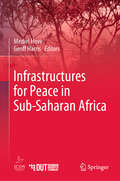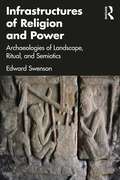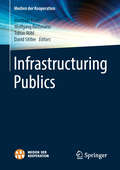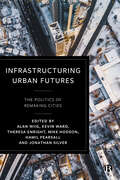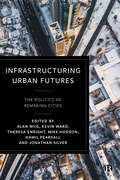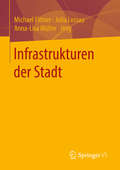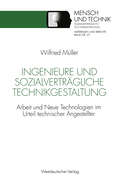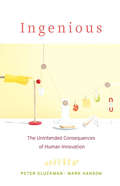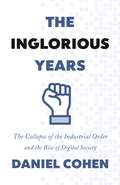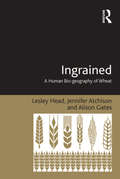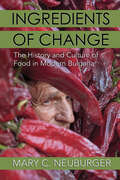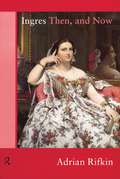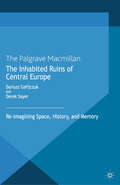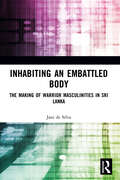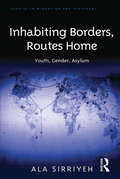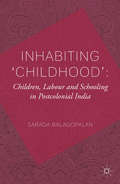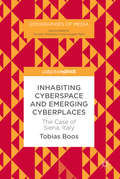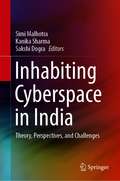- Table View
- List View
Infrastructures for Peace in Sub-Saharan Africa
by Mediel Hove Geoff HarrisCultures of violence are characteristic of many countries in sub-Saharan Africa and attempts to move towards cultures of peace have often proved difficult and ineffectual. And yet, the wide variations in levels of violence within and between countries show that it is not inevitable; rather, it is the result of choices made at individual, community and societal levels. This book examines the potential of peace infrastructures as vehicles to strengthen and spread progress towards cultures of peace. Peace infrastructures vary hugely in sophistication and level. The examples examined in this book range from tiny structures which help resolve conflicts between individuals and within community organisations, peace committees which serve local communities, peace education and peace club programmes in schools, mediation mechanisms to prevent election violence and to ministries of peace to coordinate government and non-government efforts in peacemaking and peacebuilding. The overall finding is that the development of peace infrastructures at all levels has great potential to build cultures of peace. 1. It is the only book available which documents the experience and potential of nonviolence in post-independence sub-Saharan Africa. 2. It makes a persuasive case for the development of various peace infrastructures in order to make peace sustainable. 3. It explains how strategic planning can be utilised, both to bring about change and to institutionalise it.
Infrastructures of Religion and Power: Archaeologies of Landscape, Ritual, and Semiotics
by Edward SwensonThis book explores the central role of religion in place-making and infrastructural projects in ancient polities. It presents a trilectic approach to archaeological study of religious landscapes that combines Indigenous philosophies with the spatial and semiotic thinking of Lefebvre, Peirce, and proponents of assemblage theories. Case studies from ancient Angkor and the Andes reveal how rituals of place-making activated processes of territorialization and semiosis fundamental to the experience of political worlds that shaped power relations in past societies. The perspectives developed in the book permit a reconstruction of how landscapes were variably conceived, perceived, and lived in the spirit of Henri Lefebvre, and how these registers may have aligned or clashed. In the end, the examination of built environments, infrastructures, and rituals staged within specialized buildings demonstrates how archaeologists can better infer past ontologies, cosmologies, ideologies of time and place, and historically specific political struggles. The study will appeal to students and researchers interested in ritual, infrastructures, landscape, archaeological theory, political institutions, semiotics, human geography, and the civilizations of the ancient Andes and Angkor.
Infrastructures of Religion and Power: Archaeologies of Landscape, Ritual, and Semiotics
by Edward SwensonThis book explores the central role of religion in place-making and infrastructural projects in ancient polities. It presents a trilectic approach to archaeological study of religious landscapes that combines Indigenous philosophies with the spatial and semiotic thinking of Lefebvre, Peirce, and proponents of assemblage theories. Case studies from ancient Angkor and the Andes reveal how rituals of place-making activated processes of territorialization and semiosis fundamental to the experience of political worlds that shaped power relations in past societies. The perspectives developed in the book permit a reconstruction of how landscapes were variably conceived, perceived, and lived in the spirit of Henri Lefebvre, and how these registers may have aligned or clashed. In the end, the examination of built environments, infrastructures, and rituals staged within specialized buildings demonstrates how archaeologists can better infer past ontologies, cosmologies, ideologies of time and place, and historically specific political struggles. The study will appeal to students and researchers interested in ritual, infrastructures, landscape, archaeological theory, political institutions, semiotics, human geography, and the civilizations of the ancient Andes and Angkor.
Infrastructuring Publics (Medien der Kooperation)
by Matthias Korn Wolfgang Reißmann Tobias Röhl David SittlerThe volume scrutinizes publics and infrastructures not separately but in their constitutive interrelations and resonances. The contributions, originating in a range of disciplinary perspectives, share a praxeological approach, discussing historical and current processes of mediated cooperation in infrastructuring and making public(s) by tracing different forms of the production, design, and historic trajectories of various publics and infrastructures.
Infrastructuring Urban Futures: The Politics of Remaking Cities
by Alan Wiig, Kevin Ward, Theresa Enright, Mike Hodson, Hamil Pearsall and Jonathan SilverEPDF and EPUB available Open Access under CC-BY-NC-ND licence. Focusing on material and social forms of infrastructure, this edited collection draws on rich empirical details from cities across the global North and South. The book asks the reader to think through the different ways in which infrastructure comes to be present in cities and its co-constitutive relationships with urban inhabitants and wider processes of urbanization. Considering the climate emergency, economic transformation, public health crises and racialized inequality, the book argues that paying attention to infrastructures’ past, present and future allows us to understand and respond to the current urban condition.
Infrastructuring Urban Futures: The Politics of Remaking Cities
by Alan Wiig Kevin Ward Theresa Enright Mike Hodson Hamil Pearsall Jonathan SilverEPDF and EPUB available Open Access under CC-BY-NC-ND licence. Focusing on material and social forms of infrastructure, this edited collection draws on rich empirical details from cities across the global North and South. The book asks the reader to think through the different ways in which infrastructure comes to be present in cities and its co-constitutive relationships with urban inhabitants and wider processes of urbanization. Considering the climate emergency, economic transformation, public health crises and racialized inequality, the book argues that paying attention to infrastructures’ past, present and future allows us to understand and respond to the current urban condition.
Infrastrukturen Der Biosicherheit: Zur Macht Sozio-technischer Prognoseverfahren Am Beispiel Des Syndromischen Gesundheitsmonitoring In Den Usa (Sozial- Und Kulturgeographie Ser. #53)
by Henning FüllerInfrastrukturen der Stadt
by Michael Flitner Julia Lossau Anna-Lisa MüllerDer Band befasst sich mit dem Verhältnis von Stadt und Infrastruktur, von Urbanisierung und Infrastrukturentwicklung. Je nach Konstellation symbolisieren und reproduzieren Infrastrukturen gesellschaftliche Beziehungen, können diese aber auch mit hervorbringen und stabilisieren. Das Verschwinden eines erkenntnistheoretisch eigenständigen Raums jenseits der Stadt führt dazu, dass aus der Analyse von städtischen Phänomenen zunehmend Erkenntnisse über Merkmale der Gesellschaft insgesamt zu erwarten sind. Die mit diesem Band vorgelegte Auseinandersetzung mit Infrastrukturen der Stadt offenbart damit grundlegende Mechanismen und Funktionsweisen der heutigen Gesellschaft.
Ingenieure und sozialverträgliche Technikgestaltung: Arbeit und Neue Technologien im Urteil technischer Angestellter (Sozialverträgliche Technikgestaltung, Materialien und Berichte)
by Wilfried MüllerEine gewerkschaftliche Politik der Gestaltung von Arbeit und Technik ist beim gegenwärtigen Technisierungsniveau auf die Kooperation mit Ingenieuren angewiesen. So haben Betriebsräte in den letzten Jahren immer öfter den Wunsch geäußert, bei der Einführung neuer Techniken technisch fundiert beraten zu werden.In dieser empirischen Untersuchung werden die beruflichen Erfahrungen und Orientierungen von Ingenieuren dargestellt, die der IG Metall betriebspolitisch nahe stehen. Im Mittelpunkt der Studie stehen die Bedingungen und Chancen einer sozialverträglichen Technikgestaltung im Urteil von Ingenieuren, deren Handlungsmöglichkeiten in innerbetrieblichen Innovations- und Rationalisierungsprozessen und sich abzeichnende Veränderungen der Arbeitsbedingungen in den Abteilungen EDV-Einführung, Entwicklung, Konstruktion, Arbeitsvorbereitung und Fertigung.
Ingenious: The Unintended Consequences of Human Innovation
by Peter Gluckman Mark HansonThe trouble with innovation is that it can seldom be undone. We invent technologies to modify our environments in immediately beneficial ways, but the long-term consequences can be costly. From obesity to antibiotic resistance, we pay for our successes. Peter Gluckman and Mark Hanson explore what happens when our creations lead nature to bite back.
The Inglorious Years: The Collapse of the Industrial Order and the Rise of Digital Society
by Daniel CohenHow populism is fueled by the demise of the industrial order and the emergence of a new digital society ruled by algorithmsIn the revolutionary excitement of the 1960s, young people around the world called for a radical shift away from the old industrial order, imagining a future of technological liberation and unfettered prosperity. Industrial society did collapse, and a digital economy has risen to take its place, yet many are left feeling marginalized and deprived of the possibility of a better life. The Inglorious Years explores the many ways we have been let down by the rising tide of technology, showing how our new interconnectivity is not fulfilling its promise.In this revelatory book, economist Daniel Cohen describes how today's postindustrial society is transforming us all into sequences of data that can be manipulated by algorithms from anywhere on the planet. As yesterday's assembly line was replaced by working online, the leftist protests of the 1960s have given way to angry protests by the populist right. Cohen demonstrates how the digital economy creates the same mix of promises and disappointments as the old industrial order, and how it revives questions about society that are as relevant to us today as they were to the ancients.Brilliant and provocative, The Inglorious Years discusses what the new digital society holds in store for us, and reveals how can we once again regain control of our lives.
Ingrained: A Human Bio-geography of Wheat
by Lesley Head Jennifer AtchisonPlants are fundamental players in human lives, underpinning our food supply and contributing to the air we breathe, but they are easy to take for granted and have received insufficient attention in the social sciences. This book advances understanding of human-plant relations using the example of wheat. Theoretically, this book develops new insights by bringing together human geography, biogeography and archaeology to provide a long term perspective on human-wheat relations. Although the relational, more-than-human turn in the social sciences has seen a number of plant-related studies, these have not yet fully engaged with the question of what it means to be a plant. The book draws on diverse literatures to tackle this question, advancing thinking about how plants act in their worlds, and how we can better understand our shared worlds. Empirically, the book reports original ethnographic research on wheat production, processing and consumption in a context of globalisation, drought and climate change and traces the complex networks of wheat using a methodology of 'following' it and its people. The ethnobotanical study captures a number of moments in the life of Australian wheat; on the farm, at the supermarket, in the lives of coeliac sufferers, in laboratories and in industrial factories. This study demands new ways of thinking about wheat geographies, going beyond the rural landscape to urban and industrial frontiers, and being simultaneously local and global in perspective and connection.
Ingrained: A Human Bio-geography of Wheat
by Lesley Head Jennifer AtchisonPlants are fundamental players in human lives, underpinning our food supply and contributing to the air we breathe, but they are easy to take for granted and have received insufficient attention in the social sciences. This book advances understanding of human-plant relations using the example of wheat. Theoretically, this book develops new insights by bringing together human geography, biogeography and archaeology to provide a long term perspective on human-wheat relations. Although the relational, more-than-human turn in the social sciences has seen a number of plant-related studies, these have not yet fully engaged with the question of what it means to be a plant. The book draws on diverse literatures to tackle this question, advancing thinking about how plants act in their worlds, and how we can better understand our shared worlds. Empirically, the book reports original ethnographic research on wheat production, processing and consumption in a context of globalisation, drought and climate change and traces the complex networks of wheat using a methodology of 'following' it and its people. The ethnobotanical study captures a number of moments in the life of Australian wheat; on the farm, at the supermarket, in the lives of coeliac sufferers, in laboratories and in industrial factories. This study demands new ways of thinking about wheat geographies, going beyond the rural landscape to urban and industrial frontiers, and being simultaneously local and global in perspective and connection.
Ingredients of Change: The History and Culture of Food in Modern Bulgaria
by Mary C. NeuburgerIngredients of Change explores modern Bulgaria's foodways from the Ottoman era to the present, outlining how Bulgarians domesticated and adapted diverse local, regional, and global foods and techniques, and how the nation's culinary topography has been continually reshaped by the imperial legacies of the Ottomans, Habsburgs, Russians, and Soviets, as well as by the ingenuity of its own people. Changes in Bulgarian cooking and cuisine, Mary C. Neuburger shows, were driven less by nationalism than by the circulation of powerful food narratives—scientific, religious, and ethical—along with peoples, goods, technologies, and politics. Ingredients of Change tells this complex story through thematic chapters focused on bread, meat, milk and yogurt, wine, and the foundational vegetables of Bulgarian cuisine—tomatoes and peppers. Neuburger traces the ways in which these ingredients were introduced and transformed in the Bulgarian diet over time, often in the context of Bulgaria's tumultuous political history. She shows how the country's modern dietary and culinary transformations accelerated under a communist dictatorship that had the resources and will to fundamentally reshape what and how people ate and drank.
Ingres Then, and Now (Re Visions Ser.)
by Adrian RifkinIngres Then, and Now is an innovative study of one of the best-known French artists of the nineteenth century, Jean Auguste Dominique Ingres. Adrian Rifkin re-evaluates Ingres' work in the context of a variety of literary, musical and visual cultures which are normally seen as alien to him. Re-viewing Ingres' paintings as a series of fragmentary symptoms of the commodity cultures of nineteenth-century Paris, Adrian Rifkin draws the artist away from his familiar association with the Academy and the Salon.Rifkin sets out to show how, by thinking of the historical archive as a form of the unconscious, we can renew our understanding of nineteenth-century conservative or academic cultures by reading them against their 'other'. He situates Ingres in the world of the Parisian Arcades, as represented by Walter Benjamin, and examines the effect of this juxtaposition on how we think of Benjamin himself, following Ingres' image in popular cultures of the twentieth century. Rifkin then returns to the late eighteenth and early nineteenth centuries to find traces of the emergence of bizarre symptoms in Ingres' early work, symptoms which open him to a variety of conflicting readings and appropriations. It concludes by examining his importance for the great French art critic Jean Cassou on the one hand, and in making a bold, contemporary gay appropriation on the other.Ingres Then, and Now transforms the popular image we have of Ingres. It argues that the figure of the artist is neither fixed in time or place - there is neither an essential man named Ingres, nor a singular body of his work - but is an effect of many, complex and overlapping historical effects.
Ingres Then, and Now
by Adrian RifkinIngres Then, and Now is an innovative study of one of the best-known French artists of the nineteenth century, Jean Auguste Dominique Ingres. Adrian Rifkin re-evaluates Ingres' work in the context of a variety of literary, musical and visual cultures which are normally seen as alien to him. Re-viewing Ingres' paintings as a series of fragmentary symptoms of the commodity cultures of nineteenth-century Paris, Adrian Rifkin draws the artist away from his familiar association with the Academy and the Salon.Rifkin sets out to show how, by thinking of the historical archive as a form of the unconscious, we can renew our understanding of nineteenth-century conservative or academic cultures by reading them against their 'other'. He situates Ingres in the world of the Parisian Arcades, as represented by Walter Benjamin, and examines the effect of this juxtaposition on how we think of Benjamin himself, following Ingres' image in popular cultures of the twentieth century. Rifkin then returns to the late eighteenth and early nineteenth centuries to find traces of the emergence of bizarre symptoms in Ingres' early work, symptoms which open him to a variety of conflicting readings and appropriations. It concludes by examining his importance for the great French art critic Jean Cassou on the one hand, and in making a bold, contemporary gay appropriation on the other.Ingres Then, and Now transforms the popular image we have of Ingres. It argues that the figure of the artist is neither fixed in time or place - there is neither an essential man named Ingres, nor a singular body of his work - but is an effect of many, complex and overlapping historical effects.
The Inhabited Ruins of Central Europe: Re-imagining Space, History, and Memory
by Dariusz Gafijczuk Derek SayerFocusing on Central Europe, the volume proposes a new paradigm of how culture works, based on a model of "inhabited ruins" as a space where contradictory elements come together into continually renewed and frequently paradoxical configurations. Examines art, architecture, literature and music.
Inhabiting an Embattled Body: The Making of Warrior Masculinities in Sri Lanka
by Jani de SilvaThis book offers an anthropological account of Sri Lanka’s Eelam Wars III and IV. It is based on the life-narratives of ex-servicemen who fought on the frontlines. The volume approaches militarism as a practice of masculinity. It explores the sense of embattlement that young recruits feel, which stems from the inner war between notions of bodily deference instilled in childhood and having to conduct offensives on the battlefield. Thus though they wish to move smoothly into the assault techniques learnt in combat-training, they sometimes find their bodies are acting-out a different trajectory; engaging in acts of spectacular violence or simply running away. It traverses themes such as masculinity and Sinhala society, British martial masculinity vs the composed body in Sinhala discourse, combat-training and the battlefield. The author traces the ways in which troops tried to negotiate the thin line between valour and violence in a context in which the enemy’s suicide fighters engaged in the more extreme code of sacrificing-the-body, which derided the very manliness of soldiers who couldn’t prevail against them. She argues that the Sri Lankan experience has resonance for soldiers on battlefields everywhere, who become embattled when confronted by adversaries whose practice seems to diminish their own manliness. Rich in ethnographical narratives, this book will be interest scholars and researchers of war studies, gender studies, masculinity studies, peace and conflict studies, ethnic studies, political science, international relations, sociology, social anthropology, cultural studies, and South Asian studies, especially those concerned with Sri Lanka.
Inhabiting an Embattled Body: The Making of Warrior Masculinities in Sri Lanka
by Jani de SilvaThis book offers an anthropological account of Sri Lanka’s Eelam Wars III and IV. It is based on the life-narratives of ex-servicemen who fought on the frontlines. The volume approaches militarism as a practice of masculinity. It explores the sense of embattlement that young recruits feel, which stems from the inner war between notions of bodily deference instilled in childhood and having to conduct offensives on the battlefield. Thus though they wish to move smoothly into the assault techniques learnt in combat-training, they sometimes find their bodies are acting-out a different trajectory; engaging in acts of spectacular violence or simply running away. It traverses themes such as masculinity and Sinhala society, British martial masculinity vs the composed body in Sinhala discourse, combat-training and the battlefield. The author traces the ways in which troops tried to negotiate the thin line between valour and violence in a context in which the enemy’s suicide fighters engaged in the more extreme code of sacrificing-the-body, which derided the very manliness of soldiers who couldn’t prevail against them. She argues that the Sri Lankan experience has resonance for soldiers on battlefields everywhere, who become embattled when confronted by adversaries whose practice seems to diminish their own manliness. Rich in ethnographical narratives, this book will be interest scholars and researchers of war studies, gender studies, masculinity studies, peace and conflict studies, ethnic studies, political science, international relations, sociology, social anthropology, cultural studies, and South Asian studies, especially those concerned with Sri Lanka.
Inhabiting Borders, Routes Home: Youth, Gender, Asylum (Studies in Migration and Diaspora)
by Ala SirriyehIn recent years there has been growing interest in the experiences of young people seeking asylum in Europe. While the significance of the role of age is recognized, both youth transitions and trajectories beyond the age of eighteen are still largely unexplored, the role and impact of mobility predominantly centering on experiences of movement from country of origin to country of settlement. Inhabiting Borders, Routes Home contends that in considering migration and settlement experiences of young refugees it is also important to consider the role of their mobility through age and transitions in the country of settlement. Based on narrative research with young refugees, this book explores how migration journeys are intertwined with life course journeys and transitions into adulthood, shedding light on the manner in which gender intersects with age in experiences of migration and settlement, with close attention to the processes by which 'home' is understood and constructed. Through the concept of 'home' the book draws together and reflects on interconnections between integration in areas such as education or housing and experiences of social networks. Examining experiences of the asylum process and the manner in which they are interwoven within a wider narrative of home both within and beyond, Inhabiting Borders, Routes Home will be of interest to social scientists working in the areas of migration, asylum, intersectionality and the life course.
Inhabiting Borders, Routes Home: Youth, Gender, Asylum (Studies in Migration and Diaspora)
by Ala SirriyehIn recent years there has been growing interest in the experiences of young people seeking asylum in Europe. While the significance of the role of age is recognized, both youth transitions and trajectories beyond the age of eighteen are still largely unexplored, the role and impact of mobility predominantly centering on experiences of movement from country of origin to country of settlement. Inhabiting Borders, Routes Home contends that in considering migration and settlement experiences of young refugees it is also important to consider the role of their mobility through age and transitions in the country of settlement. Based on narrative research with young refugees, this book explores how migration journeys are intertwined with life course journeys and transitions into adulthood, shedding light on the manner in which gender intersects with age in experiences of migration and settlement, with close attention to the processes by which 'home' is understood and constructed. Through the concept of 'home' the book draws together and reflects on interconnections between integration in areas such as education or housing and experiences of social networks. Examining experiences of the asylum process and the manner in which they are interwoven within a wider narrative of home both within and beyond, Inhabiting Borders, Routes Home will be of interest to social scientists working in the areas of migration, asylum, intersectionality and the life course.
Inhabiting 'Childhood': Children, Labour And Schooling In Postcolonial India
by S. BalagopalanThrough a rich ethnography of street and working children in Calcutta, India, this book offers the first sustained enquiry into postcolonial childhoods, arguing that the lingering effects of colonialism are central to comprehending why these children struggle to inhabit the transition from labour to schooling.
Inhabiting Cyberspace and Emerging Cyberplaces: The Case of Siena, Italy
by Tobias BoosThis book explores the concept of cyberplace as a mode of inhabiting the contemporary world. As a result, it suggests that, for many communities, unlocking cyberspace and inhabiting cyberplaces is now an integral part of their coming-to-the-globalised-world. Boos reviews in the detail the existing academic literature from cultural anthropology, human geography, and sociology on “cyberspace”, concluding that a phenomenological perspective on cyberspace provides the possibility of gaining a deep understanding of our contemporary lifeworlds, in which on- and offline practices constantly intermingle. In four chapters, he applies the developed theoretical and methodological approaches to the case of Siena’s neighbourhoods, the contrade, analysing their websites and discussing the implications of his findings for understanding contemporary processes of community building and for future research on cyberspace.This concise and accessible book will be of interest to advanced students and scholars in cultural anthropology, human geography, media studies and sociology.
Inhabiting Cyberspace and Emerging Cyberplaces: The Case of Siena, Italy
by Tobias BoosThis book explores the concept of cyberplace as a mode of inhabiting the contemporary world. As a result, it suggests that, for many communities, unlocking cyberspace and inhabiting cyberplaces is now an integral part of their coming-to-the-globalised-world. Boos reviews in the detail the existing academic literature from cultural anthropology, human geography, and sociology on “cyberspace”, concluding that a phenomenological perspective on cyberspace provides the possibility of gaining a deep understanding of our contemporary lifeworlds, in which on- and offline practices constantly intermingle. In four chapters, he applies the developed theoretical and methodological approaches to the case of Siena’s neighbourhoods, the contrade, analysing their websites and discussing the implications of his findings for understanding contemporary processes of community building and for future research on cyberspace.This concise and accessible book will be of interest to advanced students and scholars in cultural anthropology, human geography, media studies and sociology.
Inhabiting Cyberspace in India: Theory, Perspectives, and Challenges
by Simi Malhotra Kanika Sharma Sakshi DograThis book gathers a selection of essays on the multifaceted aspects of cyber culture in India, both online and offline. It presents an in-depth analysis of cyberspace and its components, while also exploring its lived reality. The respective contributions highlight theoretical perspectives that address questions of relationality regarding all aspects of cyber culture in India, from the physical to the virtual. Bearing in mind India’s vast cultural diversity, which is shaped by different levels of political, social, and economic development, the book offers nuanced studies that analyze the complexities of cyberspace and digital culture in India. The book appeals to all readers interested in technology, cultural studies, online communication networks, feminism, virtual diasporas, and sociology.
